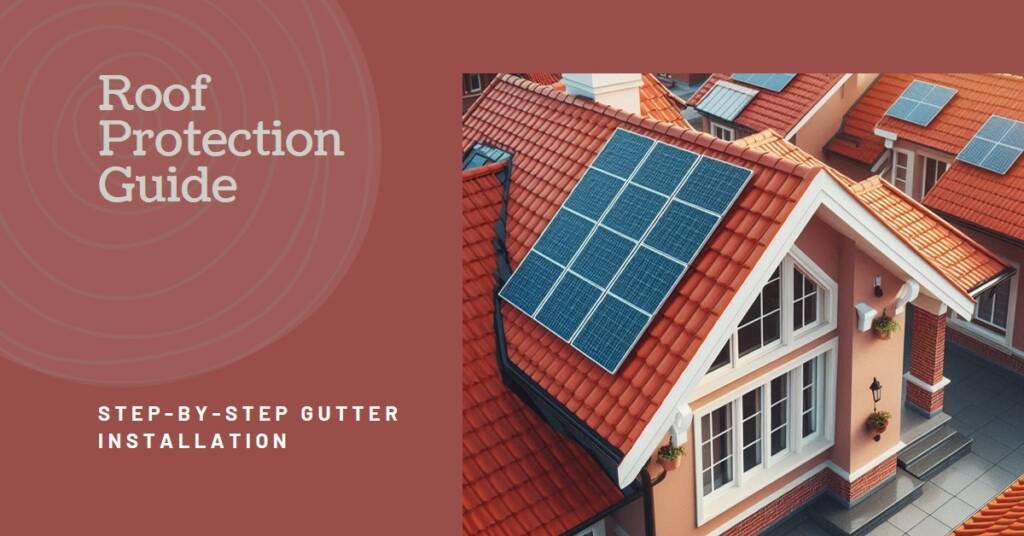
Table of Contents
Understanding the Importance of Gutters
Gutters are an essential component of any home’s roofing system, playing a critical role in directing rainwater away from the structure. Properly installed and maintained gutters ensure that water flows efficiently from the roof to the downspouts, ultimately discharging it away from the foundation. This prevents a multitude of water-related issues, safeguarding both the structural integrity of the home and the surrounding landscape.
Without an effective gutter system, rainwater can cascade down the sides of a house, leading to serious problems such as foundation damage, roof deterioration, and basement flooding. When water is not channeled away, it can pool around the base of the home, creating an environment conducive to erosion. Erosion can undermine the foundation, leading to costly repairs and potentially reducing the lifespan of the home. Additionally, standing water can attract pests, including mosquitoes and termites, further exacerbating the potential for damage.
Furthermore, the lack of gutters can cause significant harm to landscaping features. Soil erosion can lead to the loss of plants and vegetation, while frequent flooding can stifle growth and lead to muddy areas that are difficult to maintain. Over time, this damage not only impacts the aesthetic appeal of the property but can also diminish its overall value.
Investing in a quality gutter system, coupled with regular maintenance, can yield substantial long-term benefits. A functional gutter system protects against costly repairs linked to water damage, maintains the visual integrity of the property, and enhances the efficacy of drainage systems. Maintaining gutters free of debris also ensures that they remain effective during heavy rainfall, reducing the likelihood of overflow situations. Ultimately, gutters serve as a vital safeguard for any property, contributing significantly to both immediate and long-lasting protection of roofs and foundations.
Choosing the Right Gutter System
When selecting a gutter system for your home, it is essential to consider various factors that will affect both functionality and aesthetics. Among the primary choices are sectional and seamless gutters. Sectional gutters come in predetermined lengths and are joined together, making them relatively easy to install. However, they may be more prone to leaks at the seams. On the other hand, seamless gutters are custom-made from a single piece of material, minimizing the potential for leaks and often providing a cleaner look. While they may come with a higher upfront cost, seamless gutters can prove to be more cost-effective over time due to reduced maintenance and repair needs.
The material selection for gutters is equally critical. Common choices include aluminum, vinyl, and copper. Aluminum gutters are lightweight, resistant to rust, and available in various colors, making them a popular choice among homeowners. Vinyl gutters are an excellent option for those seeking a budget-friendly solution, as they are inexpensive and easy to install but may not withstand extreme temperatures and heavy debris as well as other materials. Copper gutters, noted for their stunning appearance and durability, can add an element of luxury to your home; however, their higher cost and maintenance requirements may deter some homeowners.
To determine the required length of gutters, a precise measurement of the roofline is necessary. Use a level to measure the roof’s edge, ensuring to account for any slopes or corners. Additionally, consider the style of gutters that will best complement your home’s architectural features—whether traditional, modern, or a specific design element. Matching your gutter system to the overall aesthetic of your home not only enhances its appearance but also increases its value. Ultimately, choosing the right gutter system is crucial to maintain the integrity of your roof and protect your home from water damage.
Tools and Materials Needed for Gutter Installation
Installing gutters requires specific tools and materials to ensure a successful and safe completion of the project. A well-prepared toolkit can enhance efficiency and effectiveness throughout the installation process. Here is a comprehensive list of necessary items.
First and foremost, a sturdy ladder is essential. Opt for an extension ladder that can safely reach the height of your roof. Ensure that it is placed on stable ground and is secure during use, as this enhances safety significantly. Along with the ladder, safety equipment is crucial. This includes hard hats, safety goggles, and gloves. Proper safety attire helps mitigate the risks associated with working at heights.
Next, gather your primary materials: the gutters themselves. These can come in various materials, including aluminum, vinyl, and copper. Choose gutters that fit your home’s aesthetic while also considering durability and cost. In addition to the gutters, you will need brackets and hangers that will support the gutter system. These components hold the gutters in place, so selecting the appropriate size and type is vital.
Additionally, a level is necessary to ensure that the gutters are properly aligned. An inaccurate slope can lead to water pooling, defeating the purpose of effective water management. Along with the level, a saw (either a manual or power saw) will be needed to cut the gutters to the correct lengths. Remember to have a measuring tape on hand for precise measurements.
Lastly, sealants help prevent leaks in the gutter system. Choose a high-quality gutter sealant to maintain the integrity of the installation. Having all these tools and materials prepared prior to starting the project not only streamlines the process but also emphasizes the significance of safety precautions throughout the installation of gutters.


Preparing the Roof and Area
Before embarking on the installation of gutters, it is essential to adequately prepare both the roof and the surrounding area. This preparatory phase not only facilitates a smoother installation process but also ensures longevity and functionality for the new gutter system.
The first task is to clean the roof thoroughly, removing any debris such as leaves, twigs, and dirt. Accumulated debris can obstruct water flow and cause damage to the roof or the new gutter system once installed. It is advisable to use a roof rake or a broom to gently clear the surface, ensuring no debris is left behind that could interfere with the installation.
Next, it is imperative to conduct a thorough inspection of the roof and fascia board for any existing damage. Look for broken shingles, cracks, or loose fascia that might compromise the integrity of the new gutters. Addressing any repairs before installation is critical, as it helps avoid potential leaks and inefficiencies in the water drainage system.
Another important factor to consider is the proper slope for the gutters, which is vital for optimal water flow toward the downspouts. A general rule of thumb is to aim for a slope of about 1/4 inch for every 10 feet of gutter. This slope ensures that rainwater flows smoothly along the gutters and into the downspouts, minimizing the risk of water pooling and overflow.
By taking the time to prepare the roof and its surroundings meticulously, homeowners can set a solid foundation for a successful gutter installation. This initial investment in preparation plays a crucial role in the efficiency and durability of the gutters, safeguarding the home from water-related issues in the long run.
Step 2: Installing Gutter Hangers and Brackets
Once you have determined the correct alignment and slope for your gutters, the next step is to install the gutter hangers and brackets. These components are essential for securely supporting the gutters and ensuring they function properly by facilitating adequate water drainage.
Begin by measuring and marking the locations for the hangers on the fascia boards. A common guideline is to space the hangers every two feet along the length of the gutter. Accurate measurements are crucial; improper spacing can lead to sagging or detachment of the gutters over time. Once the positions are marked, ensure that all hangers will maintain the slope you’ve previously established, which should typically be a quarter inch for every ten feet of gutter. This angle is vital for proper water flow towards the downspouts.
Next, prepare the hangers for installation. Depending on the type of hangers you have selected—either bracket style or adjustable—pay attention to the associated fastening system. For bracket-style hangers, align them so that the back of the bracket is flush against the fascia, and the front edge is parallel to the gutter. When using adjustable hangers, ensure they accommodate the slope you’ve determined earlier.
To fasten the hangers securely, use galvanized or stainless-steel screws, as these materials resist corrosion. Drill pilot holes to prevent splitting the wood, and then insert the screws to secure the hangers firmly into place. Ensure the hangers are level with each other and adequately spaced to provide maximum support without hindering the flow of water. After all hangers are installed, you can proceed to attach the gutters, knowing they are well-supported by the properly installed hangers and brackets.
Cutting and Attaching Gutters
Once the necessary measurements have been taken, the next critical step in the installation of gutters involves cutting the gutter material to the appropriate length. Accurate cutting is essential to ensure a snug fit, which will help prevent water leaks and drainage issues. Begin by laying the gutter material flat on a stable surface, such as a sawhorse or workbench. Using a fine-toothed saw, carefully cut the gutter pieces according to your predetermined measurements. It is advisable to wear protective eyewear during this process to safeguard against debris.
After cutting, it is important to handle the seams between sections properly. When joining two pieces of gutter, overlap them slightly and ensure that the seams are aligned correctly. This not only aids in maintaining the aesthetic of the installation but also plays a significant role in ensuring that water flows smoothly through the system. To achieve a watertight fit, it is crucial to apply a high-quality sealant along the seam before connecting the two sections. This sealant acts as a barrier against moisture and prevents potential leaks.
Attaching the gutters to the hangers is the next step in the process. Begin by positioning the hangers at regular intervals—typically every two feet—for optimal support. Once again, ensure that the hangers are aligned based on the slope needed for proper drainage. Secure the gutters to the hangers using rust-resistant screws. If your gutter system includes internal or external corners, it is imperative to pay extra attention to these areas, ensuring all connections are sealed properly. With these techniques in place, you will create a robust and effective gutter system capable of protecting your roof from water damage.
Step 4: Installing Downspouts
Once the gutters have been securely attached, the next step involves the installation of downspouts, which play a critical role in funneling water away from your home’s foundation. Proper placement and installation of downspouts are essential for maintaining the effectiveness of your gutter system and preventing water damage.
Begin by determining strategic locations for your downspouts. It is advisable to position them at corners or where the gutters accumulate the most water to maximize efficiency. Ideally, downspouts should be spaced no more than 40 feet apart, depending on the slope and roof’s drainage capability. Use a level to ensure that gutters slope toward the downspouts, allowing water to flow freely without stagnating.
The next step involves measuring and cutting the downspout pipes. Typically made from vinyl or metal, downspouts come in standard lengths. Measure the height from the bottom of the gutter to the ground, and cut the downspout according to these measurements. When cutting, ensure that you are wearing appropriate safety gear to protect against sharp edges. After cutting, assemble the downspout sections, ensuring that each segment is aligned correctly.
Once assembled, secure the downspouts to the house using brackets. Brackets should be installed every 10 feet to ensure stability. It is crucial that these brackets are properly fastened to prevent the downspouts from pulling away from the house, particularly during heavy rainfall. Additionally, consider installing downspout extensions at the bottom to direct the water at least 6 feet away from the foundation, helping to mitigate potential drainage issues. These extensions can help prevent erosion and water pooling, which can compromise your home’s structural integrity.
In conclusion, the strategic installation of downspouts is vital for an effective gutter system. By methodically placing, measuring, cutting, and securing downspouts, homeowners can ensure that rainwater is effectively managed, safeguarding their property against potential water-related damage.
Step 5: Final Checks and Adjustments
After completing the installation of the gutters, it is crucial to perform a series of final checks and adjustments to ensure that everything functions as intended. Proper functioning of gutters is vital for protecting your roof, walls, and foundation from water damage. The first step in this process is to inspect the alignment of the gutters and downspouts. It is essential to confirm that the gutters slope gently toward the downspouts, typically at a pitch of about 1/4 inch for every 10 feet. This slope helps facilitate optimal water flow, minimizing the chances of accumulation and overflow.
Next, inspect the seams where the gutter sections join and pay special attention to the areas around downspouts. Leaks in these areas can lead to significant issues if not promptly addressed. Utilizing a garden hose, run water through the installed gutters, beginning at the farthest point from the downspout. Observe how the water flows and check for any signs of leaks, ensuring that any water is directed toward the downspout without pooling in undesired areas.
Additionally, remove any debris that may have accumulated during installation or leftover from your surroundings. Blockages can significantly hinder the performance of your gutters, increasing the risk of overflow and subsequent water damage. If any blockages are found, make the necessary adjustments, ensuring that your gutters leading to the downspouts are clear and unobstructed.
Finally, verify that the hangers and brackets are securely fastened and that the gutters are not sagging. Adjustments may be required to achieve the ideal positioning and secure fit. By taking these final steps, you can rest assured that your new gutter system will effectively protect your home from potential water damage, ensuring longevity and efficiency.
Maintaining Your Gutter System
Regular maintenance of your gutter system is crucial to ensure its longevity and functionality. Over time, gutters can accumulate debris such as leaves, twigs, and dirt, which can hinder the proper flow of water. It is recommended that homeowners inspect and clean their gutters at least twice a year, typically in the spring and fall. However, those living in areas with heavy foliage or severe weather conditions may require more frequent maintenance. Frequent checks can help prevent blockages that lead to potential water damage to the roof and foundation.
Cleaning gutters involves removing any visible debris. This can often be done with a simple scoop or trowel, followed by a rinse with water from a garden hose to ensure that the downspouts are free-flowing. For those hesitant about climbing ladders or performing the task themselves, hiring a professional service can be advantageous. Professionals can also assess the condition of the gutters, identifying any necessary repairs or reinforcements that may be needed.
Homeowners should also remain vigilant for signs that indicate professional help might be necessary. These signs can include persistent leaks, sagging gutters, or an overflow of water during rainstorms, which may suggest that your system is blocked or damaged. Additionally, if you notice mold or mildew forming around your home’s foundation or walls, this could indicate that your gutters are not functioning properly, allowing water to seep into inappropriate areas.
Proper maintenance of your gutters is essential not only for the gutters themselves but for the structural integrity of your home as a whole. By adhering to a regular cleaning schedule and addressing potential issues promptly, homeowners can protect their investment and ensure that their gutter system continues to function effectively.


